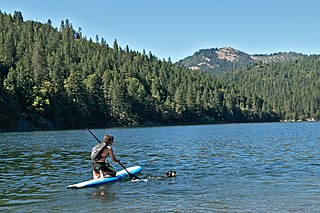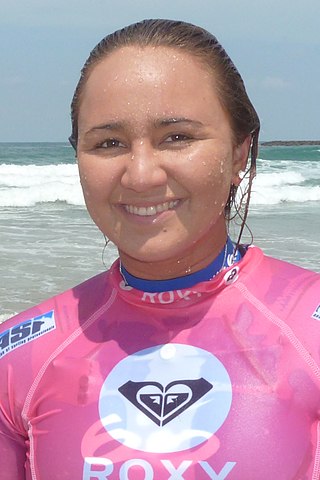
Duke Paoa Kahinu Mokoe Hulikohola Kahanamoku was a Hawaiian competition swimmer who popularized the sport of surfing. A Native Hawaiian, he was born to a minor noble family less than three years before the overthrow of the Hawaiian Kingdom. He lived to see the territory's admission as a state, and became a United States citizen. He was a five-time Olympic medalist in swimming, winning medals in 1912, 1920 and 1924.

Surfing is a surface water sport in which an individual, a surfer, uses a board to ride on the forward section, or face, of a moving wave of water, which usually carries the surfer towards the shore. Waves suitable for surfing are primarily found on ocean shores, but can also be found in standing waves in the open ocean, in lakes, in rivers in the form of a tidal bore, or in wave pools.

Robert Kelly Slater is an American professional surfer, best known for being crowned World Surf League champion a record 11 times. Slater is widely regarded as the greatest professional surfer of all time, and holds 56 Championship Tour victories. Slater is also the oldest surfer still active on the World Surf League, winning his 8th Billabong Pipeline Masters title at age 49.

Laird John Hamilton, né Zerfas, is an American big-wave surfer, co-inventor of tow-in surfing, and an occasional fashion and action-sports model and actor. He is married to Gabrielle Reece, a former professional volleyball player, television personality, and model.

Big wave surfing is a discipline within surfing in which experienced surfers paddle into, or are towed into, waves which are at least 20 feet high, on surf boards known as "guns" or towboards. Sizes of the board needed to successfully surf these waves vary by the size of the wave as well as the technique the surfer uses to reach the wave. A larger, longer board allows a rider to paddle fast enough to catch the wave and has the advantage of being more stable, but it also limits maneuverability and surfing speed.

Vincent Sennen "Sunny" Garcia is an American professional surfer from Waianae, Hawaii. After leaving school he debuted on the 1986 Gotcha Pro at Sandy Beach, Oahu, beating the 1984 champ Tom Carroll.
Greg Noll was an American pioneer of big wave surfing and a prominent longboard shaper. Nicknamed "Da Bull" by Phil Edwards in reference to his physique and way of charging down the face of a wave, he was on the U.S. lifeguard team that introduced Malibu boards to Australia around the time of the 1956 Summer Olympics in Melbourne. He produced a "legendary" series of five Search for Surf films.
Patrick Shane Dorian, or "Shane", is an American surfer from Kailua-Kona, Hawaii. He spent 11 years touring on the World Championship Tour as a professional surfer. Dorian quit competition surfing in 2003 to focus on big waves. He is currently a big wave surfer and one of the best in the world at big wave riding.

Surf culture includes the people, language, fashion, and lifestyle surrounding the sport of surfing. The history of surfing began with the ancient Polynesians. That initial culture directly influenced modern surfing, which began to flourish and evolve in the early 20th century, with its popularity peaking during the 1950s and 1960s. It has affected music, fashion, literature, film, art, and youth jargon in popular culture. The number of surfers throughout the world continues to increase as the culture spreads.

The riding of waves has likely existed since humans began swimming in the ocean. In this sense, bodysurfing is the oldest type of wave-catching. Undoubtedly ancient sailors learned how to ride wave energy on many styles of early boats. Archaeological evidence even suggests that ancient cultures of Peru surfed on reed watercraft for fishing and recreation up to five thousand years ago. However, standing up on what is now called a surfboard is a relatively recent innovation developed by the Polynesians. The influences for modern surfing can be directly traced to the surfers of pre-contact Hawaii.

Paddleboarding is a water sport in which participants are propelled by a swimming motion using their arms while lying or kneeling on a paddleboard or surfboard in the ocean or other body of water. Paddleboarding is usually performed in the open ocean, with the participant paddling and surfing unbroken swells to cross between islands or journey from one coastal area to another.
The U.S. Open of Surfing is a week-long surfing competition held annually during the summer in Huntington Beach, California. Generally held on the south side of the Huntington Beach Pier, the U.S. Open is part of the qualification process for the World Surf League and is a WSL QS 10,000 event. It is the largest surfing competition in the world. It has been owned by IMG since 2000.
David Earl Weber, known as Dewey Weber, was an American surfer, a popular surfing film subject, and a successful surfboard manufacturing businessman. Throughout the 1950s and 1960s, he distinguished himself with a surfing style unique at the outset of that era. Out of the water, he had already become a national yo-yo champion and a CIF champion in wrestling, then appeared in several feature films, and eventually established a successful surfboard manufacturing company. On November 14, 2015, the city of Hermosa Beach unveiled at its Community Center a sculpture inspired by a photo of Dewey Weber taken by surf photographer Leroy Grannis.

Carissa Kainani Moore is a Hawaiian American Olympian, world champion surfer and activist. She was the first-ever winner of the Olympic Gold Medal in women's short board surfing in 2020. She was also the 2011, 2013, 2015, 2019 and 2021 World Surf League WSL Women's World Tour Champion. Moore is the first surfer in history to win a WSL world title and the Olympic title in the same year.
Gary Elkerton, known as Kong is an Australian surfer, three time world masters champion, three time world professional runner-up, twice Hawaiian Triple Crown champion and Australian amateur champion (1984). He is regarded as an iconic big-wave rider and is highly respected by his peers for his unique, powerful surfing style. In 2009, Gary was inducted into the Australian Surfing Hall of Fame.
Sean Mattison is an American former professional surfer and current professional surf coach, known mostly for designing "The Nubster", a fifth surfboard fin. Mattison is also the designer of his own alternative high performance surfboards and surfboard fins named Von-Sol.
Donald Moke Takayama was an American professional surfer and surfboard shaper. Originally a longboard surfer, Takayama won the Master's division of the United States Surfing Champions in 1971, 1972 and 1973. Hawaiian born, Takayama learned to surf at Waikiki Beach and moved to California in the mid-1950s. Takayama died of complications from heart surgery; he is survived by his wife and four daughters.

Dog surfing is a type of surfing maneuver involving dogs that are trained to surf on surfboards, bodyboards, skimboards, windsurf boards or to bodysurf. Historically, surfing dogs have been documented as occurring as early as the 1920s in the United States. Competitions and exhibitions that feature surfing dogs have occurred in various coastal areas of the United States, such as Del Mar, California, Imperial Beach, California and Jupiter, Florida.
Chris Christenson is an American surfboard shaper, craftsman, and outdoor enthusiast.













